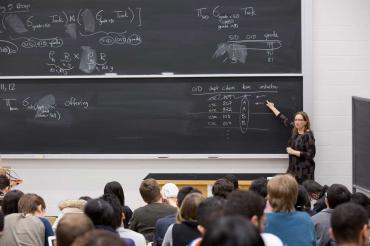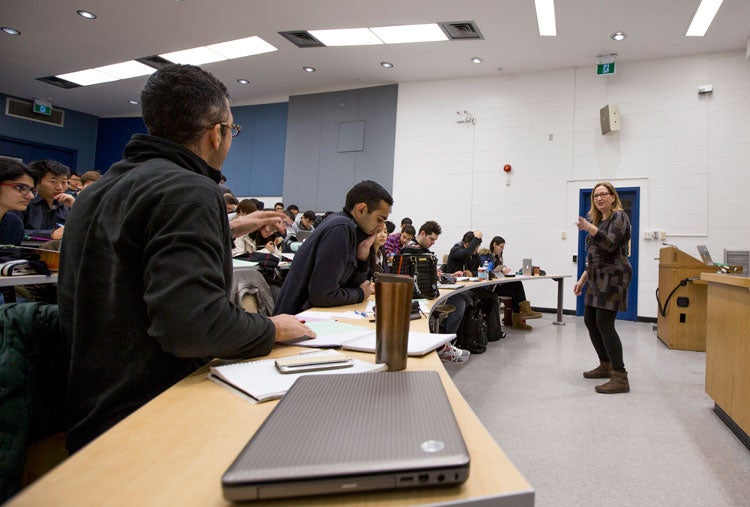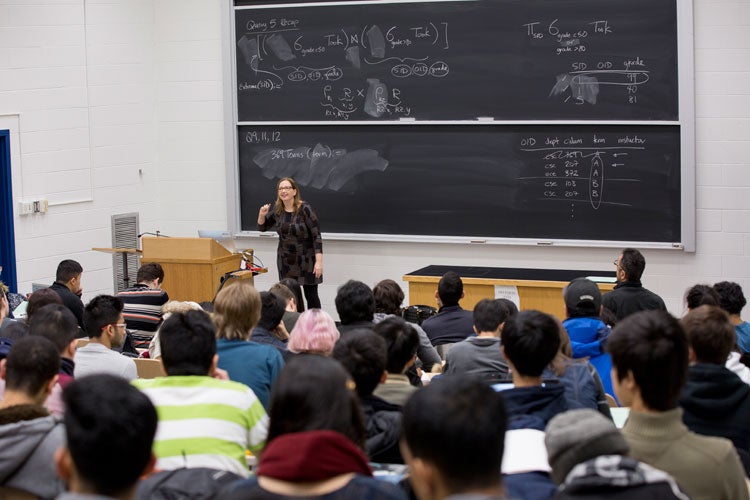Innovations in teaching: Diane Horton

Published: May 24, 2016
Convocation is a time to celebrate U of T's students. Although they may make it look easy, graduating from one of the top-ranked universities in the world is a remarkable achievement.
When an estimated 13,500 grads cross the stage at Convocation Hall in ceremonies beginning next week, they'll be looking back at years of exams, essays, lab and field work, experiential learning, volunteer stints, creativity and hard work. And almost zero snow days.
On the stage with them – or following via live streams and Instagram feeds – will be some of the professors and instructors who also invested countless hours in their students’ success.
Who are the teachers who helped make this day possible? You can learn about some of them in our Inside Con Hall series from student writer Krisha Ravikantharaja.
And you’ll meet a few more in this series on Innovations in Teaching.
In this first instalment, U of T News writer Arthur Kaptainis profiles Diane Horton, associate professor (teaching stream) in the department of computer science.
Student weekends are not what they were in the era before inverted teaching.
“On Sunday afternoon, even Saturday night, I get questions on my discussion board,” Diane Horton, associate professor (teaching stream) of computer science and one of three winners of the 2015 President’s Teaching Awards, said in her office in the Bahen Centre.
“Asking for clarification where they are stuck, on points that never used to come up before the midterm or the assignment. Now they come up right away because by Sunday night students have to be ready for the next week.”
The central idea behind inverted teaching is to move core content to learning sources outside the class, typically videos. Class time is used to solve problems.
“Instead of using classes to go over the definitions, rudimentary things that you can learn on your own, students are engaged in activities that exercise that knowledge and those skills,” Horton explained.

There is an element of psychology in the system.“When you just listen to a presentation in a lecture, you are not necessarily absorbing very much. When you put pen to paper and try to do something with it, you realize ‘Oh, that seemed to make sense, but when I try to answer this question, I can’t.’”
It might seem anachronistic to speak of pen and paper in the context of a computer science class, but Horton’s second-year course on software design starts with the algebra at the heart of programming language SQL (pronounced “sequel”). Greek letters are easier to render the old-fashioned way.
When the exercises are ready, students use the Programming Course Resource System (PCRS), an online tool developed by undergraduates under the supervision of Andrew Petersen, another 2015 President’s Teaching Award winner.
Inverted teaching (“flipped” is a synonym) normally inverts content and process. Horton also distinguishes accessible knowledge, which students can acquire on their own, from material that is more challenging. Class time is dedicated to the latter.
“Imagine you’re teaching a kid how to build LEGO,” Horton says. “You’ve given him or her all those two-by-four little blocks. Putting them together is easy. Soon the kid will discover that a zigzag creates a strong wall and that if you create a crevasse, that’s a weak spot.
“I let the students work on their own to create the wall. When they come to class they have another problem: build a corner.”
Then the stakes are raised again. Build a roof.
“Suddenly the hands go up and the prof is running round the room,” Horton said. “Students learn more that way. It’s very engaging.”
Students agree. “Professor Horton leads you to the wall of knowledge, and gives you the tools to break through that wall on your own,” says Christopher Koehler, a second-year computer science specialist.
“It is a refreshing experience to learn difficult concepts so easily in class instead of spending countless hours studying at home.”

The innovative process is coupled with old-fashioned love of teaching. “She is very enthusiastic when it comes to teaching the course material,” according to Oscar Chen, a fourth-year specialist. “She was always available for office hours if any students had extra questions.”
Julia Gilenko, a second-year specialist, recalls how Horton managed to make a learning experience even out of a new computing program that was not performing up to expectations. “Diane is a very engaging lecturer who clearly enjoys the work she does,” she says.
It is a source of both satisfaction and pride to Horton to teach in a computer science department that consistently places high in international rankings. Research-stream and teaching-stream faculty work in tandem. As associate chair for undergraduate studies from 2002 to 2007, Horton consulted broadly with her colleagues in redesigning the undergraduate curriculum.
“I feel grateful to be working in this department,” she says. “Everywhere I look there are brilliant people.”
Horton also feels that the resources available to teaching-stream faculty are better at U of T than in many other schools. Her teaching prize is not solely honorary. It comes with an $10,000 annual professional development award over five years.
Perhaps the biggest bonus of working in an acclaimed department is a premium cohort of students. Applications have skyrocketed and entry standards with them. Many undergraduates are destined for careers as programmers but the diversity can be surprising. Two of three forrmer dancers with the National Ballet of Canada now studying at U of T have enrolled in computer science courses.
“It’s great to have students coming from every direction,” Horton says. “They bring so much to us when they have an interest in linguistics or drama or psychology or physics. Whatever it is, they bring something with them.”




